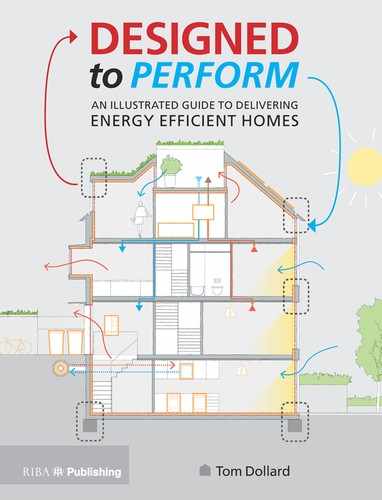Design for performance?
Designing for performance requires rigour in the specification and design process. It requires the project team to challenge typical assumptions and investigate the difficult details. It needs design teams to engage with the specialists at the right stages with an iterative modelling and design process that is followed to its conclusion.
This book has shown a number of common problems and performance issues when designing and constructing new homes. The details illustrated are an aid for designers to improve their own specific drawn information for new homes. They should help draw, write and test production information that is based on the realities of the building site to improve performance. In addition to making use of the good practice details in this book, designers need to challenge the way they currently work and enact the following:
Construction for performance
The introduction to this book asks what contractors can do to improve performance of the building, and gives some solutions to the performance gap. The most effective solution improves both the energy performance and also the construction quality relating to structural, fire, acoustic, damp, moisture, longevity, services and aesthetics; the complete performance of the building. The key reccommendation for contractors to ensure complete performance is to enact a rigorous quality management system with greater responsibility and role for the design team, sub-contractors, warranty providers and clerk of works on site. Effective step change can be brought about by revising sub-contractor tender packages, consultant appointments, meetings and checking processes to align with quality and performance. An insulation installer who is paid per complete house is unlikely to prioritise quality, especially if they know the site manager is too busy to check the continuity of the insulation. To improve quality, the tender requirements need to outline some simple performance checks, and rates of payment linked to these checks, rather than just getting the job done quickly. In addition the site manager and design team should discuss these performance requirements, checks and payment terms with the sub-contractors at a pre-start meeting.
This revised quality management system should include a quality manual for the site that explicitly sets out the performance requirements and offers illustrated examples of good practice and unacceptable standards. The contractor can engage with the design team in an iterative, continuous process, giving feedback on the designs and getting specialist input where necessary. The quality management system should ensure that commissioning is robust and transparent, and has a third-party check by a specialist or experienced clerk of works. It should require a sustainable design champion in the form of a site architect, engineer or technical manager to ensure consistent quality of products and installation.
Client's role: how to get a home that performs!
Homes should meet their intended comfort and energy consumption in order to meet their function; a comfortable shelter to live. In the U.K. most homes are delivered speculatively without a resident to engage with. However, some developers, clients and future residents have control over the brief and can set the parameters for success, which should include:
This book has highlighted a number of practical ways in which the quality of new-build homes can be improved. The drawings, photos and appendices can be used in practice to improve the design and construction process. The recommendations in the book should assist design teams, contractors, policy makers and clients to recognise poor performance and deliver better homes. Wide-scale improvement will need further training and guidance, but crucially it will require renewed regulation, enforcement and a culture that demands homes to perform.
